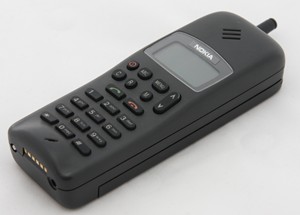The change to digital and (some) data.

Nokia 1011 - Nokia's first 2G phone.
2G or second generation mobile phone technology initiated the move to digital technology; which allows for greater network capacity. The aim of 2G was to switch to digital from analogue making for a more secure network with greater capacity. The focus was still very much on phone services. With 2G the new GSM network architecture was introduced, which is still the basis of mobile phone network architectures. The emphasis was on a phone network and te only devices connected to the 2G network wer mobile phones.
As well as phone services simple SMS messaging was available. This used the spare capacity on the control channel. SMS provided a second and different messaging mechanism that had not been seen before.
Data was also supported but as a dial-up connection on the phone system. the user could have a phone call or send data but not both. Speeds were measured in Kbps rather than the Mbps. The Internet was available but very slow.
Later, as data became more important, enhancements were made to 2G. Most notably GPRS where a separate packet switched always-on network for data was available. Later enhancements to this network were introduced with Edge technology. By this time 2G was a respectible network but too slow for the modern user
In the UK there were four 2G networks (Vodafone, O2, Orange and T-Mobile). These are still maintained and used today predominantly for phone calls.
*u* ©mobilephonetechnology.co.uk all rights reserved 2017- 2026



